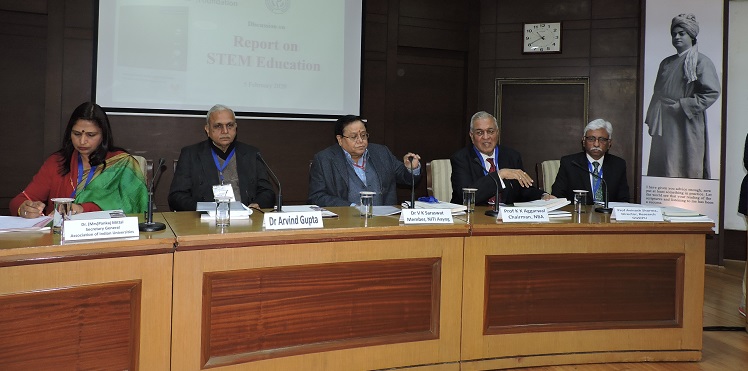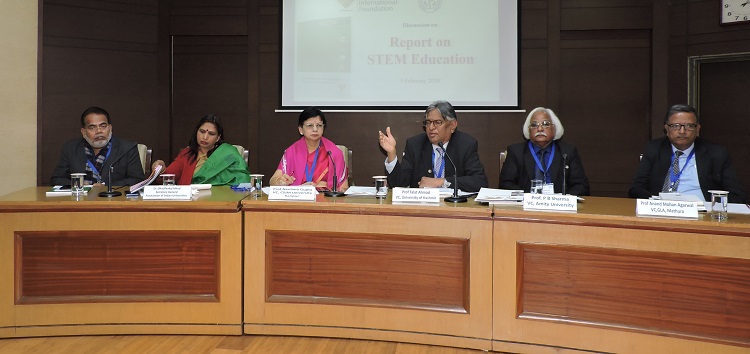

The Vivekananda International Foundation organized a seminar to discuss a VIF taskforce report on STEM education in India launched in 2019. The report, titled, “Towards More Effective Education: Emergence of STEM Education in India” was written under the Chairmanship of Prof KK Aggarwal, Chairman, National Board of Accreditation. This report which is available on the VIF website was discussed in a follow up session, organised jointly by the VIF and Association of Indian Universities on 05 February 2020.
The inaugural remarks were made by Dr Arvind Gupta, Director, VIF, to acknowledge the salience of Science, Technology, Engineering and Mathematics (STEM) education in the present day ‘knowledge economy’. This is giving rise to the formation of the new power pyramid, where technology has a strategic implication for nations. He further remarked that in India’s socio-economic transformation, education will be the single-most deciding factor. The new education policy thereby needs to pay special attention to STEM disciplines, encouraging critical thinking and innovation.

Dr Mrs Pankaj Mittal, Secretary General, Association of Indian Universities (AIU), began by cautioning against the obsolete degrees that Indian education system is providing to its students. She further validated her point by listing the 10 most employable skills or technologies or industries for 2030, including AI (Artificial Intelligence), IOT (Internet of Things), Crypto, Space Tourism, among other areas. She further asserted that foreign cooperation can give the required fillip to STEM education in India.
Prof KK Aggarwal, stated that India needs to go in for the emerging technologies as a necessity today on a larger and quality scale. Digitising and incorporation of technology is the only way to ensure equality in society today. Prof Aggarwal highlighted some of the important points from the taskforce report, like the need for a different mutant of B.Tech curriculum required in India today. A multi-disciplinary approach in case of BScs and MScs also needs to come in the picture. Concurrently, the quality of PhDs is a great concern for the nation. He hints to some of the alternatives that have been suggested in the report. He insists that computational thinking and leadership qualities needs to be developed in every student from every discipline. He sought recommendations from the university vice chancellors present in the audience, to develop science as a culture in the Indian society.
Taking on from where Prof Aggarwal left, Dr Avinash gave a small presentation on the findings of the taskforce report. The report studies how the higher education system in India is prepared to catch up with the Industrial 4.0. He highlighted the pivotal components of Education 4.0, primarily leveraging Information and Communications Technologies (ICT). A high-skilled work force is required to deal with this revolution. He also addressed the substantial gap between science, technology, engineering and mathematics, which also needs to be bridged urgently. He stressed on the importance of creating non-academic jobs for our PhD scholars in the private sector. This will give the much-needed boost to the industrial R&D sector. He further read out some of the excerpts from the conclusion of the report.

Dr VK Saraswat, in his presidential address, mentioned the due attention paid to STEM education around 2015 which led to an upward swing in India’s position on the innovation ladder. He emphasised on the lack of foundational skills in mathematics and language which are students carry forward in the higher stages of education. This is the weakness, he believes, which must be overcome. Moreover, STEM education should be a continuation process to be started from the primary level of education. This calls for an active set-up of well-equipped laboratories and infrastructure for doing scientific experiments, i.e. a greater emphasis on practical education and innovation inducing methods. Dr Saraswat encouraged development of a whole new ecosystem to promote design thinking instead of rote learning. He suggests can we can get some inspiration from the initiatives taken by countries like the US, UK or even Singapore.
Structured discussions were followed after the foundational remarks by the discussants. The first technical session was chaired by Prof Dilip Chandranath. The speakers further elaborated on the concepts touched upon in the inaugural session. The role of ICT in developing a STEM temperament in the country was discussed in detail during this session. Simultaneously, emphasis was laid on the practical applications of ICT to be included in the curriculum. It was suggested that linkages should be created between the good and not-so-good colleges, so that technology and facilities can be shared with all. A healthy mentor-mentee relationship can also benefit our students.
The second and third technical sessions were held in a combined manner. The focus was shifted to the lack of skilled teachers in the higher education system. This calls for the collective training of teachers along with the students. Another speaker highlighted the involvement of industries which has promoted STEM in some countries. It was realized that until and unless government participates in these matters, the progress will not be fully realized. Also, the research and innovation should be focused on reaching to the people who can be benefitted by it.
To prepare the students for the future jobs, universities themselves need to innovate by leveraging the government policies like National Innovation and Startup Policy. Another scheme, called Swayam, was introduced by the GOI to improve the quality of teaching. The point which came forward was that the universities have to pro-actively adopt and adapt to these schemes. Going forward there should also be a change in the examination pattern practiced by the institutes. And the most important point is the relinking of jobs with the degree. The demographics can be a strong force, if used strategically, in India. It should be used by India to compete with the rest of the world.
The sessions were followed by Q&A, where more suggestions and ideas were exchanged during the course of the seminar.
Links:
[1] https://www.vifindia.org/event/report/2020/march/20/discussion-on-report-on-stem-education
[2] https://www.vifindia.org/author/Radhika-Daga
[3] http://www.facebook.com/sharer.php?title=Discussion on Report on STEM Education in collaboration with Association of Indian Universities&desc=&images=https://www.vifindia.org/sites/default/files/discussion-on-report-on-stem-education.jpg&u=https://www.vifindia.org/event/report/2020/march/20/discussion-on-report-on-stem-education
[4] http://twitter.com/share?text=Discussion on Report on STEM Education in collaboration with Association of Indian Universities&url=https://www.vifindia.org/event/report/2020/march/20/discussion-on-report-on-stem-education&via=Azure Power
[5] whatsapp://send?text=https://www.vifindia.org/event/report/2020/march/20/discussion-on-report-on-stem-education